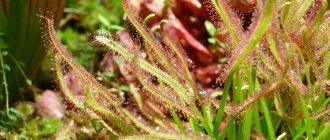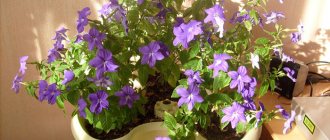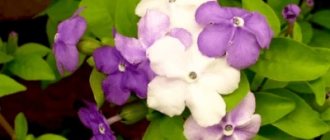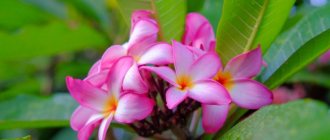Drimiopsis - This home plant will be loved by everyone who prefers beautiful bright green leaves to showy flowers. It does not require special attention, forgives mistakes made in care and is not picky about the conditions in which it is grown. Despite the fact that this plant comes from the tropics, it thrives in the microclimate of city apartments. Drimiopsis lives a long time, reproduces easily, has good endurance and is very beautiful, which is probably the reason for its great popularity among gardeners who grow houseplants.
Origin and history of Drimiopsis:
Drimiopsis (Drimiopsis) is a herbaceous perennial belonging to the Hyacinth subfamily and the Asparagus family. The plant is native to the southern and eastern parts of the African continent. Under natural conditions, it grows as a ground cover plant, forming a continuous deciduous carpet. When grown at home, it often develops rosettes.
The name is translated from Greek as similar to drimia. This is probably due to its similarity to sea onions. The plant has another name - Ledeburgia, nicknamed Scylla. The fact is that the flower was discovered by Karl Friedrich von Ledebur, who is a naturalist and researcher of flora in African countries and thanks to whom the first flower growing school was founded in the Russian Empire. He also headed the first botanical garden in Rus'. The flower was named after him. The nickname Scylla does not appear in our time, but in the 19th century the plant was called this quite often, including in botanical books.
Plant characteristics
- Species : from the genus of herbaceous perennials, evergreen or deciduous, subfamily of the hyacinth family Asparagus.
- Flower/fruit color : It blooms with small flowers in greenish-white, grayish-pink or cream shades.
- Leaf color : General olive green with dark spots and dots.
- Sun Requirement : Reaches for full sun, it is recommended to place the plant in bright, indirect sunlight.
- Size : grows up to 30-50 cm. Grows slowly.
- Flowering : gradual blooming of flowers, period - from mid-spring to early autumn.
- Aroma : light, pleasant, similar to the aroma of lily of the valley.
Drimiopsis is considered a hardy plant that adapts to conditions of insufficient care. However, it is better not to experiment and follow simple recommendations for growing a flower. The plant will respond to care with bright leaves and regular flowering.
Drimiopsis species:
Today there are about 22 species of this beautiful plant, but only 14 have a scientific description and official registration. Only two types are used for growing at home.
Drimiopsis kirk, also called Ledeburgia bortioides. The height of the plant is about half a meter. Its bulb is very similar to a regular onion. Its color is white and round in shape. The leaves are leathery and lanceolate in shape. They reach 40 centimeters in length and 5 centimeters in width. Starting from the central part, the leaves begin to taper towards their tip. The upper side of the leaf is bright green in color and is covered with dark brown spots with a green tint. The lower part has a gray tint.
The embossed veins are clearly visible. The leaves are located on very short petioles. Flowering shoot 30 centimeters high. In its natural habitat, flowering begins in the middle of the spring season, and ends only with the beginning of the autumn season. At this moment, the plant is strewn with white and pink flowers. During the period of vegetative rest, new leaves do not appear.
Drimiopsis spotted is also called ledeburgia petiolate. During the period of vegetative rest, it completely lacks foliage, first losing its variegated color. The heart-shaped leaves grow up to 12 centimeters long and 7 centimeters wide. This species has an elongated petiole and is about 20 centimeters. Flowering begins in mid-spring and ends in mid-summer. The flowering shoots on which beige-yellow flowers are formed have a slight bend.
This species fully lives up to its name.
In summer, the plant will be comfortable in the garden or on the balcony, becoming a decoration.
How it blooms
Depending on the type, the leaves can be of different shades. Often they are plain , but they also come with patterns on the surface.
All flowers are collected in colorful inflorescences. They can be either white or cream. Less often, the buds acquire a yellowish tint. One inflorescence can contain from 10 to 30 small buds, collected in spikelet-shaped inflorescences.
Each of them includes up to 30 whitish-green flowers . The diameter of each opened bud is within 5 mm. The flowering process lasts for 2-3 months.
Creating optimal conditions:
Regardless of the fact that drimiopsis comes from the southern countries of the African continent, it has already managed to fully adapt to our conditions, which are strikingly different from the conditions in which they originated.
Drimiopsis loves the sun and is drawn to it, therefore, so as not to warp, every week the vase must be turned to the light in different directions.
Good conditions will be created if the plant is located on the south side, southeast or southwest. In summer, it is best to keep it on the terrace, loggia or balcony. It is important not to expose plants to drafts, but at the same time ensure constant ventilation.
Signs and superstitions
Some believe that this plant should not be kept at home, while others believe that it is the opposite. There is an opinion that if dark spots on the leaves disappear in the summer or spring , then damage or the evil eye has been cast on the family.
It is also believed that drimiopsis calms the nervous system, prevents quarrels and improves relationships between relatives . It has a particularly positive effect on those born under the sign of Pisces.
Scylla also establishes harmony and instills positive emotions in those who visit the home.
Illumination:
In order for patterns to appear on the leaves that increase the decorativeness of the plant, it is necessary to provide it with bright, diffused lighting. Drimiopsis will feel good in direct sunlight, but during periods of extreme heat, especially in the daytime, it is necessary to create partial shade for it to avoid burns. It is important to remember that in the shade, the plant becomes less decorative. Also, leaving the plant in conditions of only artificial lighting will not provide comfortable conditions.
Fertilizer and feeding
During the growing season, which occurs from the beginning of spring to autumn, it is necessary to fertilize with large amounts of calcium, potassium, phosphorus and nitrogen . It is recommended to fertilize the plant twice every 30 days.
An excellent option is the drug "FlorGumat". In winter there is no need to contribute funds.
Humidity level:
Humidity level is not important for drimiopsis. If you provide it with proper watering, it will feel good even where the air is very dry, especially if it is not the only indoor plant in this room. Spraying, showering and wiping the leaves is necessary only to maintain hygiene and in extreme heat, and the water should always be warm.
By exposing the plant to the north side, or where the plant will not see the sun, it will not provide conditions under which its decorative properties will be preserved, but growth will continue.
Caring for drimiopsis at home
Drimiopsis acquires its best decorative qualities in bright but diffused sun. It lives well in direct sunlight, but during extreme heat, the rays can burn its leaves. Therefore, the plant must either be shaded on a hot afternoon, or initially choose a place where the sun does not hit the foliage.
Important! Since drimiopsis is an extremely light-loving plant, its foxes tend to turn and, as it were, reach for the sun. To ensure uniform foliage growth and give the plant the correct shape, experts advise turning its other side toward the light every day.
The temperature regime of drimiopsis is quite simple. In summer - 20-25 degrees, but 30 degrees will be the norm for the plant. In winter, at rest – 12-16 degrees. However, it should be remembered that at temperatures below 7-8 degrees the plant will most likely die.
to water the plant as the earthen clod dries out. It does not need spraying, but likes wiping the leaves with a damp sponge for plant hygiene. The only time a plant will enjoy spraying is in extreme heat.
The air around the plant does not require additional humidification . Drimiopsis tolerates home humidity well. But the plant will be grateful for the presence of another type of indoor plant nearby. Together they will create comfort and establish their own microclimate.
The place of residence of drimiopsis must be selected from windows on the south, southwest or southeast side. Windows oriented to the north will not allow the plant to appear in all its beauty.
Important! Drimiopsis, like any tropical plant, does not like drafts and can get sick.
Feeding drimiopsis is carried out only during the period of active plant growth, with a frequency of 2 times a month. You can use complex fertilizer for bulbous plants, but fertilizers for succulents and cacti are also suitable.
How and when to transplant:
Until the age of three, drimiopsis needs to be replanted annually, and each time the pot should be 3 centimeters larger in diameter. Those who have reached this age and up to 5 years are transplanted only once. Older bulbs should only be replanted when the daughter bulbs can no longer fit in the pot, usually once every 4 years. This procedure should be carried out from March to April.
The formation of daughter bulbs is very active, but the development of the root system is quite slow. Therefore, for drimiopsis, you need to choose a container that is low and wide, like a bowl or bowl. A container made of natural ceramics is best suited, as it provides better air exchange, which will protect the bulbs from rotting. There should be drainage holes on it.
There is no need to choose a deep and large pot, as this can cause the development of rot, and the above-ground part will begin to grow slowly.
The flower likes soil that is loose, light and nutritious. To make it yourself, you will need to use humus, leaf soil, compost and river sand for preparation. All this is mixed in equal parts and charcoal is added there, which will serve as a useful additive.
It is possible to use universal soil made of sand, vermiculite and perlite 3 x 1 x 2, as well as universal soil, which bulbous plants love, made of peat chips and coarse sand 2 x 1.
When replanting plants, you must carefully inspect all the bulbs each time and remove damaged areas using a clean and sharp knife.
Transplanting this plant is quite simple, so even a novice gardener can cope with this task. To do this, just follow simple rules.
First, you need to make a three-centimeter drainage layer at the bottom of the pot from expanded clay, broken bricks and charcoal. Next, lay out the earthen mixture, which will cover 3/4 of the pot and water it without using too much water.
After this, you need to remove the plant from its original place, clean the bulb from the soil and separate the daughters in such a way as not to cause damage.
The next step is to clean the bulbs from damage and rotten areas. Having done this, you need to treat the wounds with activated carbon, chalk or wood ash. You can also soak the bulbs in a pale pink potassium solution or one percent fungicide for 20 minutes and let them dry in the shade for an hour.
As soon as the processing of the bulbs has been carried out, you need to make a hole or several in a new place and plant the bulbs there. Make sure that half of the bulbs remain on the surface.
Afterwards, you need to carefully compact the soil and water it. Subsequent care is no different from previous care.
Mature, overgrown plants often have daughter bulbs, which, with their number, push the mother bulb to the surface of the soil. Because of this, it is deprived of proper nutrition, so the formation of leaves stops. If this happens, you don’t need to get rid of it, you just need to transplant it to another place, into a small container. This plant will not lose its ability to reproduce and produce its flowers.
Spotted drimioptis
Perennial, classified as bulbous. The leaves are collected in a rosette, on long petioles, and have an elongated heart-shaped shape. The dense, thick, glossy foliage is given a decorative effect by a speckled pattern. Flowering time: April - July. Small flowers, shades from white to yellow, sometimes grayish, are collected in a spike-shaped inflorescence. They are distinguished by a subtle, unobtrusive, pleasant aroma.
During the dormant period, part of the foliage is shed, changing its color to a single color. In spring, new leaves grow back with the same mottled pattern.
Care instructions:
This type of tropical plant shows that even when growing it in completely alien conditions, you do not need to spend a lot of time and effort on care to get a beautiful plant. Drimiopsis is unpretentious and very hardy, which is certainly admirable.
When to water
Starting from April and until the first days of October, it is necessary to water after the soil dries to a depth of 4 centimeters. If it is not very hot outside, then watering once a week is sufficient. It is necessary to pour water in such a way that it does not touch the bulbs.
Soft water should be used. Thaw or rain. It should always be warm.
If this is not possible, then it must be filtered, boiled and tap water, and left for at least 2 days. You can add citric acid to water, this will help cleanse it of harmful compounds.
Despite the tolerance to drought, there is no need to regularly dry out the soil, as it will turn yellow. Excessive watering is the most dangerous for a plant; if you overwater it regularly, this will certainly destroy the flower.
Fertilizer application
Fertilizers should only be applied when the plant is awake. For feeding, liquid complex fertilizers are suitable, which are applied at intervals of two weeks. You can also use fertilizers that feed cacti and succulents. Before preparing the solution, you must read the instructions and follow the instructions therein.
Since drimiopsis loves fertile soils, it is not worth depriving the plant of fertilizing.
Drimiopsis in winter:
In winter, the plant enters vegetative rest. At this point, it may drop all the foliage or they may simply stop growing. It depends on the species being grown. Once October arrives, watering should be gradually reduced to once every two weeks. The lower the air temperature in the room, the less often watering is carried out. However, the earthen clod must not be allowed to dry out.
As for the light, everything should remain the same. There is no need to shade the plant during this period, since the sun is no longer as active as it is in the summer. There is no need to apply fertilizer.
Possible difficulties during cultivation:
Of course, drimiopsis is an unpretentious flower, but nevertheless, it is impossible to deprive it of care or do it incorrectly. Such actions will lead to the plant losing its decorative value.
If changes occur in the autumn, then do not be alarmed; the reason is to prepare the plant for rest. If changes occur during the spring-summer period, then most likely it lacks nutrients or is cramped and needs to be replanted.
Changes could be:
The leaves lose their patterns and the color becomes monochromatic, they decrease in size, the stems become thinner and begin to elongate. This happens if drimiopsis lacks light or only has artificial light.
The petioles and bulb are slimy and begin to turn black. This indicates that the plant has begun to rot. This can happen due to too frequent and abundant watering, as well as too low temperatures.
A whitish coating appears on the soil surface. This problem occurs due to stagnation of liquid in the pot. This may occur due to poor air and water permeability of the soil and too thin drainage layer.
If light spots appear on the leaves and they begin to dry in this place, then the plant has been burned.
If the leaves begin to wrinkle, droop and lose their elasticity, then most likely it does not have enough moisture.
Pests
Shchitovka
The presence of this pest can be determined by the color of the soil. The soil becomes black and the plant becomes covered with brown growths. In this case, the flower is sprayed with Metaphos.
Spider mite
All the leaves become covered with cobwebs, and small dark dots appear on the inside. Removing spider mites is easy . To do this, just treat the plant with a soap solution.
Mealybug
The insect appears in the form of small lumps that have a dirty color. In this case, the leaves are generously wiped with alcohol. This procedure is carried out once every 14 days, until the scale insect completely disappears.
Drimiopsis has not only a beautiful appearance , but also useful properties. People often use it to treat a number of diseases. Therefore, in order to not only transform your apartment, but also become the owner of a storehouse of vitamins, you just need to follow simple rules of care .
Resistance to diseases and pests:
Drimiopsis has good resistance to diseases, and is also not very popular with harmful insects. What really poses a threat to the plant is rotting of the roots and damage to the red burn, which is typical for all bulbous plants. It is not difficult to avoid these diseases; it is enough to carry out preventive measures.
Firstly, when purchasing new plants, they must be quarantined for 21 days, and cut flowers in bouquets must be kept at a good distance from those grown at home.
Secondly, you need to regularly ventilate the room so that air circulation is constant.
Thirdly, you need to inspect all indoor plants every week for pests or any damage.
Fourthly, the plant should feel free on the windowsill and not curl up.
Fifth, it is necessary to use exclusively disinfected tools, good soil and clean pots when working with plants.
When working with plants, you need to do everything carefully, slowly, to minimize possible damage, and if it occurs, immediately treat cuts or wounds.
Carrying out sanitary measures is an integral part of protecting the plant. During them, you need to wipe the leaves using a damp sponge, spray them and put them in the shower every three weeks.
Carry out watering activities without overwatering the plant.
Apply fertilizers as recommended and not more frequently as this may cause more harm than good.
Signs of diseases and pests: control methods
Sliminess, blackening on the upper scales of the bulb, on the petioles, at their base, and the appearance of a putrid odor indicate that the plant has root rot. If detected, action must be taken immediately. Replant the plant, removing all damaged areas even with the slightest signs of disease, change the soil mixture and pot. When preparing new soil, add a biological fungicide there, or dip the bulbs in it.
When thin red or crimson spots or cracks appear on the bulb, as well as dents of these colors, we can talk about stangoporosis. In this case, you must stop all watering activities for 30 days, remove all damage from the bulbs, and treat the cuts with iodine and activated carbon.
The appearance of scale insects on the plant is indicated by the appearance of yellow-red spots appearing next to rounded gray-brown growths, as well as the color of the soil turning black. In order to cope with this pest, you need to dissolve laundry soap in a small amount of water and apply this mixture to the surface of the leaves. Leave for an hour and rinse off using a warm shower. Afterwards it is necessary to treat it with insecticides and place it in a plastic bag for three days.
The appearance of a spider mite can be determined by the thin web on the petioles, black spots on the inside of the leaf and yellow spots on the outside. You can get rid of it using a soap-alcohol solution, which is applied to the leaves for 30 minutes and then washed off with a warm shower. After the procedure, you need to put the plant in a bag for three days. Acaricidal drugs can be used. They are applied four times with one week intervals. It is better to change medications every time.
Mealybugs can be identified by off-white lumps that form on the plant itself and on the scales of the bulbs, as well as by a whitish waxy coating on the substrate. To treat the leaves, you can use any alcohol tincture from the pharmacy. After processing, you need to wash it off after 20 minutes. You will also need to treat with insecticides 4 times at intervals of two weeks.
Aphids are not difficult to spot. It settles in colonies on the underside of the leaf blade. Because of them, the leaves become covered with small beige spots and stickiness appears. If they are discovered before they have had time to reproduce, then using garlic infusion will be sufficient. If the situation is advanced, then insecticides must be used, treating 3 times with an interval of two weeks.
It is important to know that root rot can only be dealt with at an early stage; if the plant already has severe damage, it must be removed and destroyed.
Aphids are a pest that settles on almost all plants, including drimiopsis.
Diseases
Most often, the plant is affected by root rot. It can be identified by the presence of dark scales on the surface of the bulb. After a while they become covered with mucus and begin to smell rotten.
Important! In order to save the plant, it is necessary to change its soil as quickly as possible. All affected areas of the roots are removed, and the sections are treated with a special agent.
Often the plant suffers from stagonosporosis. In this case, small reddish cracks appear on the surface of the bulb. You can get rid of this disease by reducing watering and moving the flowerpot to a drier room.
Reproduction methods:
Drimiopsis can be propagated using daughter bulbs, cuttings and seeds. This is not difficult to do; it is important which method is suitable for the gardener himself.
Using daughter bulbs for propagation
This method is the most common, as it is considered the simplest. To do this, it is enough to separate the daughters from the mother bulb during transplantation and move them into separate pots. This can be done not only at the time of transplantation.
When carrying out these activities, it is important to separate the bulbs so as to cause as little damage as possible. If wounds appear, they must be treated with iodine and wood ash. Crushed chalk, cinnamon and colloidal sulfur are also suitable.
Before planting them, you need to prepare small pots by filling them with humus, leaf humus and coarse sand in proportions 2x1x1, and moistening it.
After planting, the pots should be moved to a place where there will be a lot of bright and diffused light. The air temperature should be +25 degrees and not fall below. It is necessary to water once every three days, using a moderate amount of warm water.
Rooting will occur in 21 days. When they reach 4 centimeters in length, they must be transplanted into their usual soil.
Cuttings
Only Kirk's drimiopsis can be propagated in this way.
To do this, you need to carefully pull out the leaf, leaving a white base at the petiole. You can divide the planting material, if there is not enough of it, into parts whose length will be from 5 to 7 centimeters.
Before placing the petioles, you need to prepare shallow containers by filling them with peat and sand in equal quantities. There is no need to water the plant or moisten the soil. For rooting, you can use clean water or a root growth stimulator in which the petioles are placed. If water is used for rooting, then it should be changed every three days.
Containers must be kept in a greenhouse or under plastic bags, creating greenhouse conditions for them.
The temperature should not fall below +22 degrees. Every day you need to ventilate the containers and spray the soil every 3 days.
For this method of propagation, you need to choose leaves that have no signs of disease or pests, and are also free of any damage.
If you create good conditions for them, rooting will occur after 30 days, and after another two weeks, they can be transplanted into pots whose diameter will not exceed 10 centimeters. They should contain turf, leaf humus and sand in equal proportions.
Later, another transplant will be needed in containers filled with an earthen mixture in which adult plants should grow.
Seed growing method
Flower growers rarely use seed material for growing drimiopsis. This is due to the fact that the fruit set on the plant is rather weak, and the seeds, if they are not planted immediately, do not germinate.
Lighting and watering
Watering drimiopsis is infrequent at any time of the year. Between water procedures, the top earthen lump should dry out. Drimiopsis often suffer from root rot, which is caused by severe waterlogging of the soil mixture. It is better if the perennial is exposed to short-term drought. During the active life period, drimiopsis is watered no more than once a week; during the dormant period, the number of procedures is reduced by 2-3 times. The foliage is sprayed with a fine spray bottle to maintain high air humidity, but this is often prohibited. It is better to place a saucer with water or wet pebbles next to it.
With a lack of lighting, the leaf plates lose their picturesqueness and become elongated. Typically, this happens when placed on window sills with a northern orientation or deep into the room.Variegated variegated forms of drimiopsis should be kept in a room with bright light. This type of plant enjoys direct sunlight for several hours a day. Without sun, the perennial loses its spotted color. Variegated species prefer to be placed on a south-facing window, and in summer it can be taken out into the fresh air. Any variety does not tolerate stuffiness; when placed near heating devices, protect the plant with a glass screen and humidify the air more often.
Landing
The underground root system of ledeburia is poorly developed, so a deep container for indoor growing of the flower is not needed. Mistakes regarding planting a perennial in a deep container can lead to rotting of the rhizome, as well as slow growth of the above-ground part of the crop.
It would be better to plant Drimiopsis in a wide container or pot with mandatory drainage holes. It is better to choose ceramic containers.
As for the type of soil, the plant will develop well in light and nutritious soil. In garden stores you can purchase ready-made soil mixtures designed for rooting bulbous plants. Its feature will be the ability to retain moisture well inside. To make the soil for the crop more loose, peat or sand is sometimes added to it. Drimiopsis also grows well in turf soil. The acidity of the soil should be neutral. You can make the soil for planting a flower yourself. Its composition will be as follows:
- leaf soil;
- turf land;
- coarse humus and sand;
- peat and charcoal.
Before rooting a flower, it is inspected for damaged or dry areas that should be removed.
Drainage is placed at the bottom of the pot or container; it is important that it occupies approximately a third of the volume of the container. Then soil is poured into the container
The plant is placed in the center; it is important to root drimiopsis so that the upper part of the root bulb is always located above the soil surface. The soil is compacted by hand, after which the crop should be watered. The next moisturizing can be done no earlier than a week later.
Description
The drimiopsis bulb is oblong, covered with brown scales, most of which protrudes above the soil.
The foliage is dense, thick and glossy, and can be plain or spotted (most often). The shape is heart-shaped and oval, the end is pointed. The length of the leaves is up to 20 centimeters, the petioles are 10 cm. Height is up to half a meter.
The flowers are small, gray-pink or pale green, connected in a spike. One inflorescence contains up to thirty flowers, five millimeters in diameter. They emit an aroma reminiscent of lilies of the valley.
Care errors and their elimination
Common problems when growing Drimiopsis and their elimination:
| Problem | Causes | Solution |
| Blackening of petioles | Excessive watering and stagnation of moisture in the soil | Replant the crop in new soil, remove damaged areas, regulate watering |
| Stretching of stems, blanching of leaf blades | Lack of lighting | Move the flowerpot to a bright place, turn on additional lighting in winter |
| Wilting leaves | Insufficient watering | Do not allow the soil to dry out completely |
| No flowering | Improperly organized rest period | Keep in a cool room in winter, reduce watering and stop fertilizing. |











